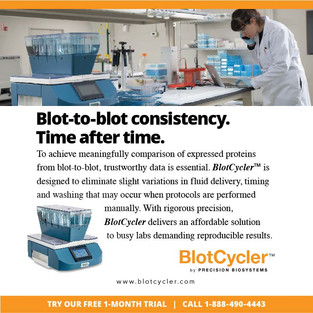Launching high tech on a shoestring
- cwhoag
- Jan 28, 2020
- 3 min read

Several years ago, Precision Biosystems, a small, Massachusetts-based start up, introduced a device that eliminated the variations that occur during western blot processing. A basic assay in biomedical research, western blots are notorious for being difficult to reproduce; they’ve been blamed for thousands of retracted articles. You’d think a device that solved this problem would be an instant hit, right?
Wrong. BlotCycler, the new product, has struggled to find acceptance. So what’s the problem?

For one, BlotCycler was positioned as an automated western blot processor, and for many labs, the word ‘automated’ sets off alarm bells. Most automated systems involve robotics, electronics and enough programming complexity to drive a lab manager to drink; which is why labs don’t even consider automation unless it is supplied by a company big enough to support it — certainly not an unknown start-up.
This is what people are missing: BlotCycler is easy to set up and even easier to use. It performs each step automatically without robotics. It doesn’t break down. Programming is simple. No new protocols or reagents are needed. Each step in the process is performed precisely, so results are consistently reproducible.
The problem is that BlotCycler suffers from a lack of awareness.
Numerous startups in the life sciences are under-capitalized, meaning they're launched on a shoestring. Inventors need the world to embrace their product once they see how great it is. But the world is a busy place. Distractions are everywhere. Messages get lost or they get confused, especially when the product’s value proposition is unclear, constantly changing or hidden from view.
Brilliant scientists, entrepreneurs and inventors can be too close to their creations. They can overlook basic marketing concepts. For BlotCycler, simple and clear messaging presented in an organized and consistent manner was needed; so here’s what we did:
First, we interviewed customers and prospects. There is no question that BlotCycler’s inventor knows more about the product than anyone, but we needed different perspectives from people in different settings. What did potential buyers think? Did they understand BlotCycler? What did they respond to?

Armed with user feedback, we formulated key marketing messages. BlotCycler is incredibly focused; it distributes reagents, applies washes and agitates samples automatically. Its precision in performing these functions is its differentiating factor. Our messages were carefully prepared to communicate these abilities.
A landing page was built focusing entirely on BlotCycler (www.blotcycler.com). It presents the key messages along with real-life examples, features, benefits, FAQs, testimonials and links to application articles. And, it makes it easy to measure interest in BlotCycler.

Outbound marketing activities were designed to bring people to the landing page. Even with a limited marketing budget, we were able to take high quality photos of BlotCycler being used in a laboratory setting. Using our key messages with these images, a series of fractional print ads was developed. The journal selected for running the ads specifically served an academic audience — our target market.
The same combination of message and graphic are being used in a series of emails, the product brochure and on signs used by the sales team for face-to-face presentations… everywhere possible.

Consistent messaging and design, including colors and type treatments, are used on all outbound messages. When people have only a few precious seconds to see and truly grasp your marketing message, you have to do everything possible to make it stand out and be memorable.
Little by little user activity on the landing page is increasing. It’s still early but the first signs of genuine interest are showing.
Effective communication is challenging. The only way to cut through the clutter is to design a focused and memorable campaign, and deliver it consistently.













Comments